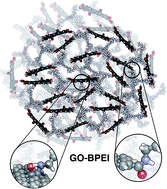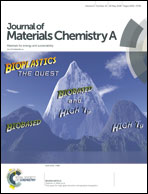Graphene oxide-branched polyethylenimine foams for efficient removal of toxic cations from water†
Abstract
Highly porous foams based on graphene oxide functionalized with polyethylenimine are generated and used with unprecedented efficiency for adsorbing heavy metal ions. A multiscale analysis of the GO–BPEI nanocomposite provided evidence for the covalent grafting of BPEI on GO and the formation of low crystalline porous foams. The uptake experiments revealed that the GO–BPEI's adsorption of toxic cations is strongly dependent on the pH in range from 2 to 10, as a result of the different interactions at the supramolecular level between the metal ions and the GO–BPEI foam. The maximum uptake capacities for Cu(II), Cd(II) and Pb(II) are achieved at pH = 5 and exhibit values as high as 1096, 2051 and 3390 mg g−1, respectively, being ca. over 20 times greater than standard sorbents like activated carbon. The GO–BPEI composite can be easily regenerated as proven by performing adsorption cycles. Also, the thermodynamic parameters including standard Gibbs free energy (ΔGo), the enthalpy change (ΔHo) and entropy change (ΔSo) revealed the exothermic and spontaneous nature of the adsorption process.



 Please wait while we load your content...
Please wait while we load your content...